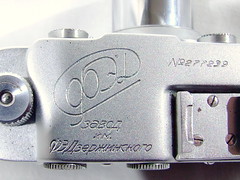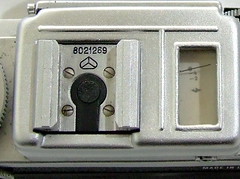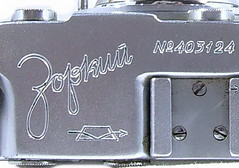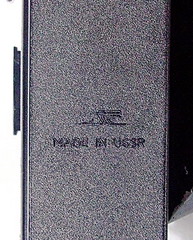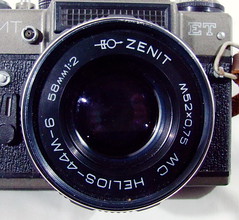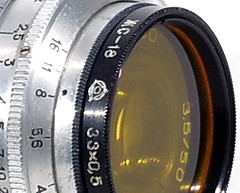Difference between revisions of "Soviet Union"
m (→Factories) |
|||
| Line 10: | Line 10: | ||
Most items of photographic equipment from the Soviet Union are marked with the '''logo''' of the factory where they were made. | Most items of photographic equipment from the Soviet Union are marked with the '''logo''' of the factory where they were made. | ||
==Factories== | ==Factories== | ||
| − | '''Gomz''' : It the was the manufacturer the early series of the famous [[Lubitel]] cameras. One of the biggest Soviet camera industry giant was [[GOMZ]] . Its name changed as LOOMP (Leningradskoje Objedinenije Optiko-Mehanicheskich Predprijatij) in 1962. It received permanent and very well-known name [[LOMO]] in 1965 (Leningradskoje Optiko-Mechanicheskoje Objedinenije) | + | *'''Gomz''' : It the was the manufacturer the early series of the famous [[Lubitel]] cameras. One of the biggest Soviet camera industry giant was [[GOMZ]] . Its name changed as LOOMP (Leningradskoje Objedinenije Optiko-Mehanicheskich Predprijatij) in 1962. It received permanent and very well-known name [[LOMO]] in 1965 (Leningradskoje Optiko-Mechanicheskoje Objedinenije). |
| − | |||
| − | |||
| − | |||
| − | |||
| − | |||
| − | |||
| − | |||
| − | |||
| − | |||
| − | |||
| − | |||
| − | |||
| − | |||
| − | |||
| − | |||
| − | |||
| − | |||
| − | |||
| − | |||
| − | |||
| + | *'''FED''': [[FED]] are the initials for F. E. Dzerzhinsky, the founder of the '''NKVD''', in honor of him the factory was named. The NKVD was the People's Commissariat for Internal Affairs (= Народный комиссариат внутренних дел Narodnyy komissariat vnutrennikh del, НКВД (=NKVD ), a public and secret police organization of the Soviet Union later known as the KGB. The factory was originally an orphanage workforce was based on youths living and working together in a commune. After the groundbreaking introduction of the Leica II in 1932, Soviet leaders stopped the import of photographic equipment and set the FED factory to its task of creating a [[Leica]] of their own. Only 18 months later, in 1934, the [[FED]] factory began churning out its first clone of the Leica II rangefinder camera. Since then, they have produced millions of cameras, some good and some not so good. The variations in the engravings on the FED camera tops make it worth a special mention, reflecting the changes within the Soviet Union. | ||
| + | *'''Arsenal''': Zavod [[Arsenal]] (= Завод "Арсенал"), Kiev, Ukraine. Arsenal is one of the oldest and most famous industrial factories in Soviet Union and later Ukraine. It is well known due to the famous Kiev cameras. The factory mainly specialized in optical components for the Soviet military and space programs. The factory also produced the professional grade photographic cameras but civil production played only a minor role in factory output. | ||
| + | *'''KMZ''' : Krasnogorsky Mekhanichesky Zavod [[KMZ]] (= Красногорский механический завод = Mechanical Factory of Krasnogorsk), is based near Moscow. KMZ is known largely for its photographic and movie cameras of the Zorki, Zenit and Moscov series, several million of which were produced. It also has a large military optics and mechanical engineering division. | ||
| + | *'''Vilejka''': The Soviet times factory '''Vileiskiy Zavod Zenit''' 's new name is Vilejka Factory, or officially OM RUP ZENIT. Founded in early 1969 in Vilejka, about 75km north-west of Minsk, as a side plant of [[MMZ]] and [[KMZ]] to produce [[Zenit]] cameras. Vilejka, has produced many Zenit models: E, TTL, ET, 11, 15, under slightly different designations. Vilejka is apparently still producing Zenits, i.e. [[Zenit 130]]. | ||
| + | *'''Valdai''': Optical-Mechanical Factory [[Valdai]] is located about 400km north-west of Moscow. Very little is known of this plant, but it has been a prolific producer of lenses for [[KMZ]], and [[Zenit BelOMO]]. The SLR lenses bear the [[Helios]] name. | ||
| + | *'''LZOS''': Lytkarino Optical Glass Factory (= Лыткаринский завод Оптического Стекла [[LZOS]]), is based in Lytkarino, 100 km north of Moscow. It was a [[KMZ]] satellite plant, included in KMZ's production union and the most famous for manufacturing various lenses for KMZ cameras. | ||
| Line 63: | Line 49: | ||
}} | }} | ||
|- | |- | ||
| − | |colspan=3 align="center"| [[FED]] factory logo on | + | |colspan=3 align="center"| [[FED]] factory logo on FED-1; [[Arsenal]] factory logo on [[Kiev]]-4M; [[KMZ]] factory logo on [[Zorki]]-1 <small>Images by Süleyman Demir {{ with permission }}</small> |
|} | |} | ||
| Line 95: | Line 81: | ||
}} | }} | ||
|- | |- | ||
| − | |colspan=3 align="center"| [[Vilejka]] factory logo on [[Zenith]] ET; [[Valdai]] factory logo on Helios 44-M-6 lens of | + | |colspan=3 align="center"| [[Vilejka]] factory logo on [[Zenith]] ET; [[Valdai]] factory logo on [[Helios]] 44-M-6 lens of Zenith ET; [[LZOS]] factory logo on Green filter on [[Kristall]] <small>Images by Süleyman Demir {{ with permission }}</small> |
|} | |} | ||
Revision as of 08:21, 25 April 2011
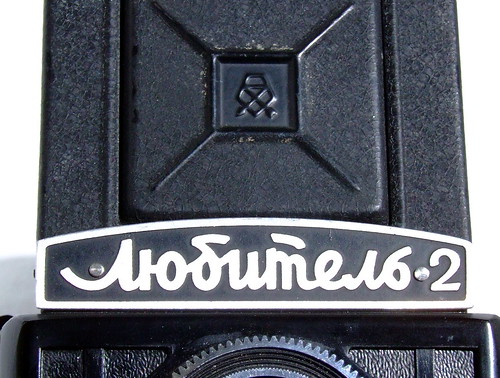
|
| GOMZ logo on the hood of a Lubitel 2 image by Süleyman Demir (Image rights) |
Most items of photographic equipment from the Soviet Union are marked with the logo of the factory where they were made.
Factories
- Gomz : It the was the manufacturer the early series of the famous Lubitel cameras. One of the biggest Soviet camera industry giant was GOMZ . Its name changed as LOOMP (Leningradskoje Objedinenije Optiko-Mehanicheskich Predprijatij) in 1962. It received permanent and very well-known name LOMO in 1965 (Leningradskoje Optiko-Mechanicheskoje Objedinenije).
- FED: FED are the initials for F. E. Dzerzhinsky, the founder of the NKVD, in honor of him the factory was named. The NKVD was the People's Commissariat for Internal Affairs (= Народный комиссариат внутренних дел Narodnyy komissariat vnutrennikh del, НКВД (=NKVD ), a public and secret police organization of the Soviet Union later known as the KGB. The factory was originally an orphanage workforce was based on youths living and working together in a commune. After the groundbreaking introduction of the Leica II in 1932, Soviet leaders stopped the import of photographic equipment and set the FED factory to its task of creating a Leica of their own. Only 18 months later, in 1934, the FED factory began churning out its first clone of the Leica II rangefinder camera. Since then, they have produced millions of cameras, some good and some not so good. The variations in the engravings on the FED camera tops make it worth a special mention, reflecting the changes within the Soviet Union.
- Arsenal: Zavod Arsenal (= Завод "Арсенал"), Kiev, Ukraine. Arsenal is one of the oldest and most famous industrial factories in Soviet Union and later Ukraine. It is well known due to the famous Kiev cameras. The factory mainly specialized in optical components for the Soviet military and space programs. The factory also produced the professional grade photographic cameras but civil production played only a minor role in factory output.
- KMZ : Krasnogorsky Mekhanichesky Zavod KMZ (= Красногорский механический завод = Mechanical Factory of Krasnogorsk), is based near Moscow. KMZ is known largely for its photographic and movie cameras of the Zorki, Zenit and Moscov series, several million of which were produced. It also has a large military optics and mechanical engineering division.
- Vilejka: The Soviet times factory Vileiskiy Zavod Zenit 's new name is Vilejka Factory, or officially OM RUP ZENIT. Founded in early 1969 in Vilejka, about 75km north-west of Minsk, as a side plant of MMZ and KMZ to produce Zenit cameras. Vilejka, has produced many Zenit models: E, TTL, ET, 11, 15, under slightly different designations. Vilejka is apparently still producing Zenits, i.e. Zenit 130.
- Valdai: Optical-Mechanical Factory Valdai is located about 400km north-west of Moscow. Very little is known of this plant, but it has been a prolific producer of lenses for KMZ, and Zenit BelOMO. The SLR lenses bear the Helios name.
- LZOS: Lytkarino Optical Glass Factory (= Лыткаринский завод Оптического Стекла LZOS), is based in Lytkarino, 100 km north of Moscow. It was a KMZ satellite plant, included in KMZ's production union and the most famous for manufacturing various lenses for KMZ cameras.
|
|
| ||||||
| FED factory logo on FED-1; Arsenal factory logo on Kiev-4M; KMZ factory logo on Zorki-1 Images by Süleyman Demir (Image rights) | ||||||||
|
|
| ||||||
| Vilejka factory logo on Zenith ET; Valdai factory logo on Helios 44-M-6 lens of Zenith ET; LZOS factory logo on Green filter on Kristall Images by Süleyman Demir (Image rights) | ||||||||
Links
- In Russian: Logos of Soviet factories at the KMZ archive site
- In English: Logos of Soviet factories at Alfred's Camera Page
